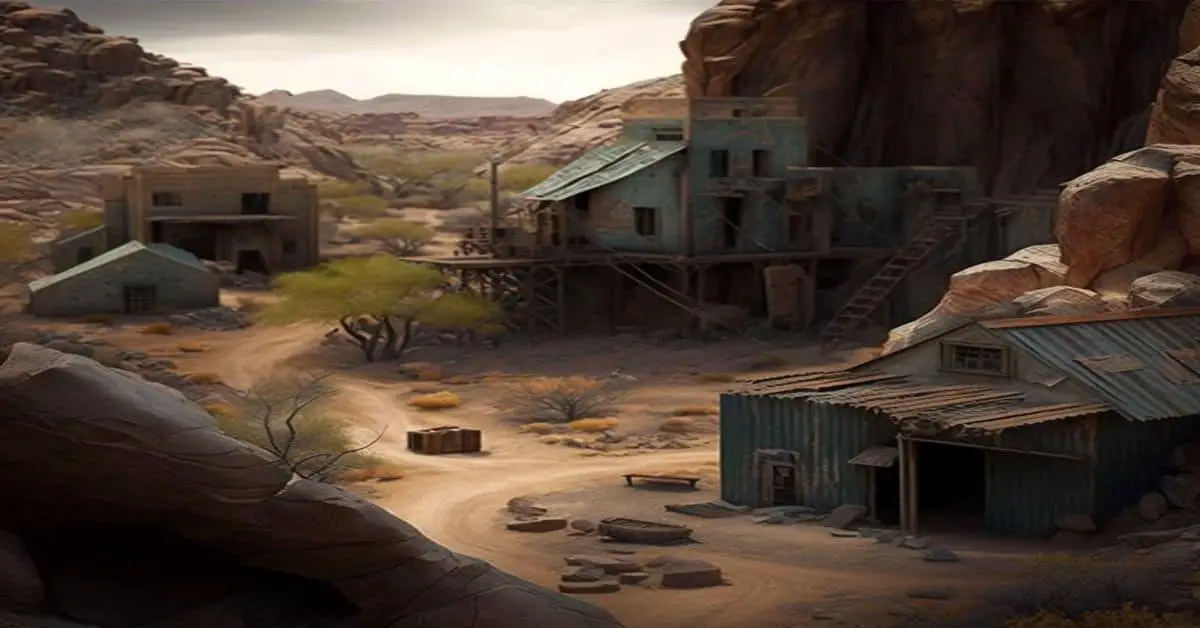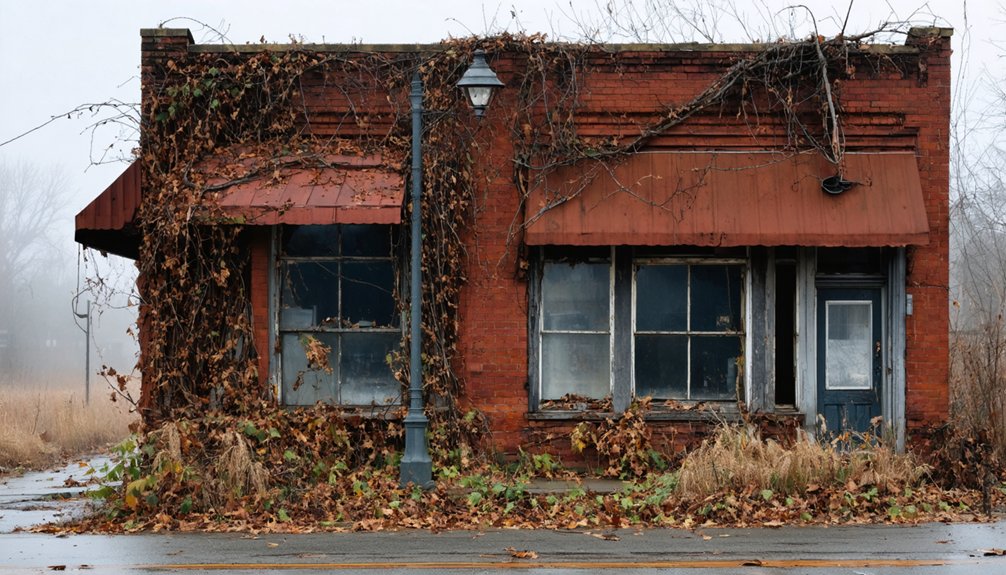You’ll find the ghost town of Beeville nestled in Lauralmie Township, Tippecanoe County, Indiana (40°13’18″N, 86°47’24″W). Established in 1884 along the Toledo, St. Louis and Western Railroad, this settlement featured a grist mill, stores, saloon, and blacksmith shop. Economic struggles and declining railroad connections led to its abandonment by the early 20th century. Today, agricultural fields cover the former townsite, though local archives preserve its brief but significant role in Indiana’s settlement history.
Key Takeaways
- Beeville was established in 1884 along the Toledo, St. Louis and Western Railroad in Tippecanoe County, Indiana.
- The ghost town is located in Lauralmie Township at coordinates 40°13’18″N, 86°47’24″W near County Road 600 East.
- During its peak, the town featured essential amenities including a grist mill, stores, saloon, and blacksmith shop.
- Economic decline occurred due to railroad deterioration, limited industry, and population migration to urban centers.
- Today, the site contains only agricultural fields with no remaining buildings, though it maintains historical significance through local archives.
The Rise and Fall of a Rural Settlement
While railroad expansion fueled the creation of countless Midwestern settlements in the late 19th century, Beeville, Indiana emerged as a modest venture in 1884 along the Toledo, St. Louis and Western Railroad.
The town planning process divided the land into at least 10 lots, though no prominent founders guided its establishment. You’ll find that despite initial hopes, Beeville never achieved substantial growth or developed lasting infrastructure. The area’s early development mirrored other settlements carved from the Northwest Territory in the 1800s.
The railroad impact proved insufficient to sustain the community. Local residents shared tales of haunted train tracks that echoed with phantom whistles at night. Without major industries or commercial ventures, Beeville relied primarily on basic railroad maintenance and local agricultural services.
As larger towns competed for resources and residents, and the railroad’s regional importance declined, Beeville gradually faded into obscurity. By the early 20th century, the settlement had been abandoned, leaving behind few traces of its brief existence.
Geographic Location and Natural Features
The precise location of Beeville’s remains can be found in Lauramie Township, Tippecanoe County, Indiana, where the forgotten settlement once stood at coordinates 40°13’18″N, 86°47’24″W.
You’ll find this ghost town near the southern border of the county, along County Road 600 East, where historical maps reveal its 1884 platting along an unused Toledo, St. Louis, and Western Railroad line. Modern GPS data for this location is available in UTM format for mapping applications.
At 796 feet above sea level, Beeville’s site reflects the typical agricultural landscape of central Indiana. Unlike its Texas namesake at 210 feet elevation, this location sits significantly higher above sea level.
Perched at a modest elevation, Beeville embodied Indiana’s heartland, where farming shaped both the land and life.
You’re surrounded by gently rolling terrain, fertile soils, and open fields that stretch across the horizon.
While no significant natural features marked the original settlement, the area continues its farming tradition with vast corn and soybean fields dominating the landscape, much as they did when Beeville was first established.
Life in Early Beeville
Settlers in early Beeville established a resilient frontier community centered around subsistence living and mutual support. You’d have found families like the Burkes and Heffermans living in simple log houses, working the land through subsistence farming to provide for their basic needs. Like Native American settlers before them, inhabitants relied on berries and nuts gathered from the surrounding forests to supplement their diets.
Your daily life would’ve revolved around tending crops, raising livestock, and maintaining strong community bonds with neighbors. A vital part of the community was the grist mill that helped process local grain.
While you’d have faced challenges from indigenous groups and Mexican conflicts, you could’ve found basic amenities at two stores, a saloon, and the local blacksmith.
The courthouse, rebuilt after fire damage, served as a symbol of civilization amid the wilderness. Religious life strengthened after the Civil War with a new church, though earlier gatherings often faced disruption from rowdy behavior.
You’d have relied heavily on ox teams to bring in rare luxuries like sugar and coffee.
Economic Challenges and Abandonment
Despite its early promise as a frontier settlement, Beeville faced mounting economic pressures that would ultimately lead to its abandonment. The town’s economic instability became evident as it struggled with limited industrial diversification and an overreliance on agricultural production. Similar to the Waldron Ice Co. venture, local businesses struggled to compete with modernizing industries.
You’d have seen the impact of deteriorating railroad connections and poor road conditions, which isolated the community from essential market access. The coal mining collapse in the region during the mid-1900s further devastated local employment opportunities.
Population migration hit Beeville particularly hard as younger residents sought opportunities in larger urban centers, leaving behind an aging population that couldn’t sustain local businesses.
The town’s infrastructure began crumbling, with failing public services and deteriorating buildings further accelerating its decline. Without access to adequate resources and faced with increasing competition from neighboring communities, Beeville couldn’t adapt to changing economic conditions, leading to its eventual desertion.
Legacy and Modern-Day Remnants
Now located in Lauramie Township near County Road 600 East, Beeville’s physical traces have largely vanished into Indiana’s rural landscape.
At an elevation of 796 feet, you’ll find only agricultural fields where this railroad town once stood. While the Toledo, St. Louis and Western Railroad that gave birth to this settlement is now defunct, Beeville’s historical significance lives on through local archives and historical collections.
The town’s brief existence mirrors common community patterns of the late 1800s, when numerous small railroad settlements dotted Indiana’s countryside. Originally developed with ten platted lots along the Norfolk & Western tracks, the small town never gained substantial growth. Like Liberty township, it faced challenges that ultimately led to its abandonment.
Today, you’ll find the site primarily used for farming, with no remaining buildings to mark its 1884 founding. Though physical remnants are scarce, Beeville’s story continues to intrigue ghost town enthusiasts and local historians studying Indiana’s settlement heritage.
Frequently Asked Questions
Were There Any Notable Crimes or Mysterious Events in Beeville’s History?
You won’t find any documented unsolved mysteries or ghost sightings in the records. Historical archives, local folklore, and police reports show no evidence of notable crimes or mysterious events.
What Happened to the Families Who Were the Last Residents?
You’d expect dramatic family stories about Beeville’s last residents, but historical records are silent. They likely drifted away gradually, taking their memories and possessions, leaving no documented trace of their fate.
Are There Any Surviving Photographs of Beeville During Its Active Years?
You won’t find confirmed photographic evidence from Beeville’s active period, though local archives like the Tippecanoe County Historical Museum might hold undiscovered images of historical significance to the community.
Did Beeville Have Its Own School, Church, or Post Office?
Ever wonder what daily life was like in tiny Beeville? While historical records don’t document any formal school, church, or post office, the limited Beeville community infrastructure reflects its small population and brief existence.
What Native American Tribes Originally Inhabited the Beeville Area?
You’ll find that Miami and Potawatomi Native tribes primarily inhabited this region, with the Miami’s cultural heritage centered along waterways and the Potawatomi’s settlements spread across northern Indiana’s prairies.
References
- https://en.wikipedia.org/wiki/List_of_ghost_towns_in_Indiana
- https://kids.kiddle.co/Beeville
- http://ingenweb.org/intippecanoe/ghosttowns.htm
- http://wikimapia.org/34624163/Beeville-Indiana-Ghost-town
- http://ingenweb.org/inlawrence/abandoned.htm
- https://www.youtube.com/watch?v=45D4dbASJyE
- https://thisisindiana.angelfire.com/indianahauntings.htm
- http://freepages.rootsweb.com/~gtusa/history/usa/in.htm
- https://www.wikiwand.com/en/articles/Beeville
- https://www.wrtv.com/news/local-news/whats-the-story-behind-story-indiana



